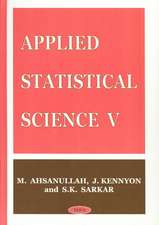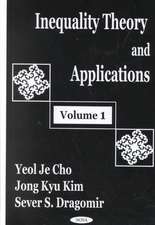Continuous Time Modeling in the Behavioral and Related Sciences
Editat de Kees van Montfort, Johan H. L. Oud, Manuel C. Voelkleen Limba Engleză Hardback – 22 oct 2018
In 16 chapters, the book addresses a vast range of topics in continuous time modeling, from approaches that closely mimic traditional linear discrete time models to highly nonlinear state space modeling techniques. Each chapter describes the type of research questions and data that the approach is most suitable for, provides detailed statistical explanations of the models, and includes one or more applied examples. To allow readers to implement the various techniques directly, accompanying computer code is made available online. The book is intended as a reference work for students and scientists working with longitudinal data who have a Master's- or early PhD-level knowledge of statistics.
| Toate formatele și edițiile | Preț | Express |
|---|---|---|
| Paperback (1) | 591.79 lei 43-57 zile | |
| Springer International Publishing – 24 ian 2019 | 591.79 lei 43-57 zile | |
| Hardback (1) | 654.62 lei 43-57 zile | |
| Springer International Publishing – 22 oct 2018 | 654.62 lei 43-57 zile |
Preț: 654.62 lei
Preț vechi: 770.14 lei
-15% Nou
Puncte Express: 982
Preț estimativ în valută:
125.30€ • 136.15$ • 105.32£
125.30€ • 136.15$ • 105.32£
Carte tipărită la comandă
Livrare economică 21 aprilie-05 mai
Preluare comenzi: 021 569.72.76
Specificații
ISBN-13: 9783319772189
ISBN-10: 331977218X
Pagini: 438
Ilustrații: XI, 442 p. 95 illus., 44 illus. in color.
Dimensiuni: 155 x 235 x 28 mm
Greutate: 0.81 kg
Ediția:1st ed. 2018
Editura: Springer International Publishing
Colecția Springer
Locul publicării:Cham, Switzerland
ISBN-10: 331977218X
Pagini: 438
Ilustrații: XI, 442 p. 95 illus., 44 illus. in color.
Dimensiuni: 155 x 235 x 28 mm
Greutate: 0.81 kg
Ediția:1st ed. 2018
Editura: Springer International Publishing
Colecția Springer
Locul publicării:Cham, Switzerland
Cuprins
Preface.- List of contributors.- First- and Higher-Order Continuous Time Models for Arbitrary N Using SEM.- A Continuous Time Approach to Intensive Longitudinal Data: What, Why and How?.- On Fitting a Continuous Time Stochastic Process Model in the Bayesian Framework.- Understanding the Time Course of Interventions with Continuous Time Dynamic Models.- Continuous-Time Modeling of Panel Data with Network Structure.- Uses and Limitation of Continuous-Time Models to Examine Dyadic Interactions.- Makes Religion Happy - or Makes Happiness Religious? An Analysis of a Three-Wave Panel Using and Comparing Discrete and Continuous Time Techniques.- Mediation Modeling: Differing Perspectives on Time Alter Mediation Inferences.- Stochastic Differential Equation Models with Time-Varying Parameters.- Robustness of Time Delay Embedding to Sampling Interval Misspecification.- Recursive Partitioning in Continuous Time Analysis.- Continuous versus Discrete Time Modelling in Growth and Business Cycle Theory.- Continuous Time State Space Modeling with an Application to High-Frequency Road Traffic Data.- Continuous Time Modelling Based on an Exact Discrete Time Representation.- Implementation of Multivariate Continuous-Time ARMA Models.- Langevin and Kalman Importance Sampling for Nonlinear Continuous-Discrete State Space Models.
Notă biografică
Kees van Montfort is a professor of Quantitative Research Methodology at the Nyenrode Business Universiteit (Department of Marketing and Supply Chain Management) and a professor of Biostatistics at the Erasmus University Rotterdam (Department of Oncology). He is currently working on quantitative data analyses with researchers from several departments of the Nyenrode Business Universiteit and the Erasmus University Rotterdam. Additionally, he is pursuing the development of new statistical methods and techniques in the field of structural equation models, state space models and survival analysis.Johan H.L. Oud is an associate professor at the Behavioural Science Institute of Radboud University, Nijmegen, the Netherlands, and visiting professor at Padjadjaran University, Bandung, Indonesia. His research interests are in family relations, structural equation modeling (SEM), longitudinal research, monitoring system construction, and continuous time analysis by means of SEM. He haspublished a series of papers and book chapters, and edited several books, in these fields. He introduced the use of structural equation modeling into discrete-time and continuous-time state space modeling. Manuel C. Voelkle is a professor of Psychological Research Methods at the Humboldt Universität zu Berlin and an adjunct researcher at the Max Planck Institute for Human Development. His research interests chiefly concern the design and analysis of multivariate empirical studies, with an emphasis on the use of structural equation models for the analysis of longitudinal data. Most of his methodological work addresses continuous time modeling and analyzing the intricate relationship of between- and within-person differences in psychological constructs as they evolve over time. He collaborates closely with other researchers in the study of developmental dynamics in affective and cognitive functioning.
Textul de pe ultima copertă
This unique book provides an overview of continuous time modeling in the behavioral and related sciences. It argues that the use of discrete time models for processes that are in fact evolving in continuous time produces problems that make their application in practice highly questionable. One main issue is the dependence of discrete time parameter estimates on the chosen time interval, which leads to incomparability of results across different observation intervals. Continuous time modeling by means of differential equations offers a powerful approach for studying dynamic phenomena, yet the use of this approach in the behavioral and related sciences such as psychology, sociology, economics and medicine, is still rare. This is unfortunate, because in these fields often only a few discrete time (sampled) observations are available for analysis (e.g., daily, weekly, yearly, etc.). However, as emphasized by Rex Bergstrom, the pioneer of continuous-time modeling in econometrics, neither human beings nor the economy cease to exist in between observations.
In 16 chapters, the book addresses a vast range of topics in continuous time modeling, from approaches that closely mimic traditional linear discrete time models to highly nonlinear state space modeling techniques. Each chapter describes the type of research questions and data that the approach is most suitable for, provides detailed statistical explanations of the models, and includes one or more applied examples. To allow readers to implement the various techniques directly, accompanying computer code is made available online. The book is intended as a reference work for students and scientists working with longitudinal data who have a Master's- or early PhD-level knowledge of statistics.
Caracteristici
This is the first and only book on continuous time modeling in the behavioral and related sciences Introduces Newtonian dynamics modeling by means of differential equations for behavioral and related sciences Covers a vast range of topics in continuous time modeling, from approaches that closely mimic traditional linear discrete time models to highly nonlinear state space modeling techniques The computer code needed for running the analyses is available online
















